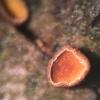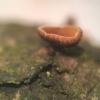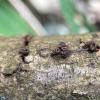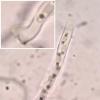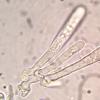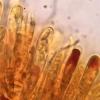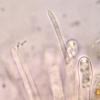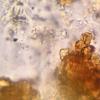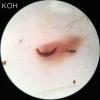
21-12-2025 09:32
Hello.A tiny ascomycete found embedded in wood in

21-12-2025 21:32
Pol DebaenstHello, Garden, Burgweg 19, Veurne, BelgiumOn 10/1

22-12-2025 23:38
Patrice TANCHAUDBonsoir, récolte sur un mur en pierre, apothéci

22-12-2025 00:47
Patrice TANCHAUDBonsoir, récolte à proximité du milieu dunaire

21-12-2025 21:40
Isabelle CharissouBonjour, j'aimerais connaitre les références de

20-12-2025 23:08
Patrice TANCHAUDBonsoir, récolte sur sol sablonneux dans l'arri�
asco possibly Encoelia-like, reviving after drying out and rehydrating
Ethan Crenson,
11-05-2024 00:33
I'm not entirely sure that Encoelia-like is the right way to describe this. These cups were found on a branch of hardwood in the Eastern US. They were brown and shriveled in the field, but rehydrated to a fairly stunning appearance when left in a moist chamber for a day. The hymenium is yellow, becoming orange brown. The receptacle is scurfy brown. They are clustered and erumpent through the bark. The largest one is slightly larger than 2mm in diameter. Some have a short pseudo stipe.
Asci:
IKI-, croziers+, clavate, 35-54 x 4-7µm
IKI-, croziers+, clavate, 35-54 x 4-7µm
Spores:
biseriate in the asci, hyaline, fusiform, sometimes slightly curved, usually with two oil drops,
5.0-7.6 (8.5) x 1.7-2.0 (2.3)µm
Me 6 x 1.9µm
N=48
Q 2.5-4.3 MeQ=3.1
Paraphyses:
septate, slightly tapering, about 2µm wide
Ectal excipulum brown, textura angularis.
Any help would be greatly appreciated.
Ethan
Hans-Otto Baral,
11-05-2024 08:32

Re : asco possibly Encoelia-like, reviving after drying out and rehydrating
Good docu! How large are the apos? Encoelia is a very small genus now. Since the paraphyses do not contain VBs I rather consider a Cordieritidaceae. Did you try KOH for the ionomidotic reaction? It could be the collemoides complex in my "Ionomidotis aff." folder.
Ethan Crenson,
11-05-2024 15:11
Re : asco possibly Encoelia-like, reviving after drying out and rehydrating
The apos are up to 2mm. KOH has yielded red pigents, so positive for ionomidotic reaction.
The embarrasing thing is that I have found this before. I just didn't recognize it. The photos labeled Ionomidotis fulvotingens ochre in your folder are my collection from Untermyer Gardens in Yonkers, NY. Is this rather something closer to I. collemoides? If possible I will sequence this. I have not had good luck sequencing Ionomidotis however.

